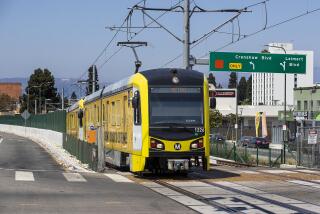Panel OKs New Digging Plan for Red Line Leg
- Share via
County transportation officials Monday decided that they do not need a full environmental review of their plan to consolidate tunneling work for the second leg of the Metro Red Line subway, a massive job involving 400 trucks a day at one construction site on Hollywood Boulevard.
Directors of the Rail Construction Corp., a branch of the Los Angeles County Transportation Commission, approved the new construction plan on a voice vote after working out a conditional compromise with homeowners and school officials on issues of noise, traffic, dust and safety.
However, Los Feliz Elementary School teacher Doris Rowe criticized the RCC for approving the plan without an environmental review. She said concerned parents and teachers will oppose the plan at an informal hearing today at the school, which is cater-corner from the excavation site at Barnsdall Park.
The Los Angeles Unified School District board scheduled the informal hearing to gauge local worries before voting on the compromise proposal Feb. 18. The transportation commission board could take up the matter the next day.
At issue is what to do with more than 1 million cubic yards of sandstone, sand and gravel--some of it almost certain to be contaminated with toxics--that will be chewed out from under Hollywood to form tunnels for the second leg of the Metro Red Line subway.
Originally, the RCC proposed to extract this material, known as tunnel spoils, out of three shafts, using four contractors. That plan was approved years ago after a full environmental review. Last year, however, staff engineers decided to combine the task into one large project and remove the spoils from one hole--but without another costly review that could delay the project for years.
RCC President Ed McSpedon said that combining the excavation sites will save $7 million in construction costs while reducing the effects of truck traffic, noise and dust by focusing them in one area where expensive mitigation measures can be applied more cost-effectively.
Barnsdall Park is the preferred site because engineers said it is large enough to let them keep most of their heavy equipment off the streets. They also said it is near the juncture of two geological strata, making it easier to use the appropriate digging equipment.
Critics complained that a single excavation site for the massive tunneling job--64,000 feet of tunnels 22 feet in diameter--would concentrate construction problems in an area crowded with the elementary school, a mental-health facility and three hospitals.
Homeowners in nearby Los Feliz were alarmed that their neighborhood was being considered to accommodate some of the estimated 400 trucks that would use the site every day--one every 3 1/2 minutes on average, virtually around the clock, hauling concrete in or carrying tunnel spoils out.
RCC negotiators defused some of the concerns by dropping Los Feliz as a truck route and reducing the number of trucks that will use Hollywood Boulevard or Vermont Street during school hours.
The RCC also agreed to give special equipment and materials to Los Feliz Elementary School under the school district’s “Adopt-a-School” program, as well as post extra crossing guards near the school, provide student shuttle buses to Barnsdall Park, and take extraordinary steps to prevent dust from wafting off the construction site.
Transit officials also agreed to help the school develop a new emergency evacuation plan to replace the one that calls for students to gather in Barnsdall Park in case of a fire or earthquake.
The most difficult part of the agreement could be cutting the number of truck trips during school hours. The RCC agreed that no more than 12 trucks will enter and leave the construction site between 9 a.m. and 2 p.m. For added safety, no trucks will move between 2 p.m. and 3 p.m., when students may linger after school ends.
Combined with earlier promises to city traffic officials that trucks will not operate during the morning and evening rush hours, this pledge means that perhaps 388 trucks will enter and leave the construction site between 6 p.m. and 6 a.m. That is an average of one truck every two minutes, all night, six or seven days a week for four years.
McSpedon said the effect would be minimal, both during jam-packed Saturday night cruising and the quiet of post-midnight weekdays.
Federal officials overseeing the project, which is partially funded by Urban Mass Transit Administration grants, said Monday that they are aware of the RCC proposal to consolidate the tunneling without preparing a new or supplemental environmental impact report.
“We will have to wait to see what the final pros and cons are on the matter,” said UMTA Regional Administrator Stewart Taylor in San Francisco, “but we are not predisposed against it.”
More to Read
Sign up for Essential California
The most important California stories and recommendations in your inbox every morning.
You may occasionally receive promotional content from the Los Angeles Times.










